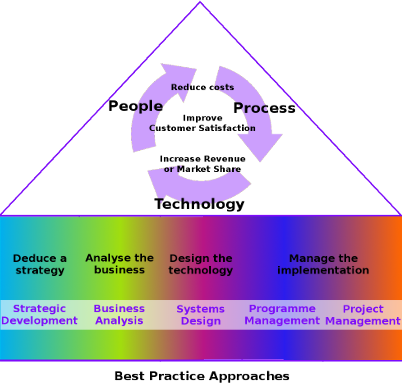SBTC, ETR: 3 mins
There are many and varied reasons why businesses embark on projects to transform the way they operate.
Before we review where these projects emanate from it helps to have an understanding of the core concepts of business transformation which we outline below.

Core concepts of Business Transformation (BT).
The need to transform tends to be DRIVEN by economic/market/business factors
It is a MANAGEMENT strategy to achieve specific objectives
-
reducing costs, improving customer satisfaction, improving profits or market share
The key disciplines that contribute to its Body of Knowledge are
-
Strategic Management
-
Organisational Development / Business Change (people)
-
Quality Management / Business Improvement (process)
-
Technology Management / Systems Design (technology)
The outcomes from BT projects have a marked impact on the future of the business
BT projects also tend to be complex projects
Types of Transformation Project.
From our experience, we have found the key DRIVER (or catalyst) for change is the business’s focus on improving its health and longevity.
The following extract highlights the drivers, benefits, types and outcomes a business seeking to change the way it operates could expect to derive from the transformation.
Driver for Change |
Business Benefit |
Type of Transformation |
Outcome |
Business Model / Organisational structure |
Moving to a new business model such as decommissioning multiple services to create a single service i.e. Central government policy (codes of practice) require disbanding multiple services to create a new service |
Radical |
Improve profits/market shareReduce costs |
Cost |
Restructuring your costs such as cutting overhead or achieving a fundamentally lower cost per unit |
Incremental |
Reduce costs |
Organisational Culture |
Changes to the norms, habits and expectations of an organization. For example, an organization with an antagonistic relationship with customers may seek to fundamentally shift towards the customer is always right or a similar culture by introducing a customer satisfaction programme |
Radical |
Customer satisfaction |
Operations |
Rethinking core business processes as opposed to improving them i.e. a manufacturing company introducing robotics and AI into its all of its manufacturing processes |
Modular |
Reduce costs |
Quality |
Poor quality is a fundamental problem i.e. making product/service more efficient and effective and the impact on improving customer satisfaction |
Architectural |
Reduce costsCustomer satisfaction |
Technology |
Dramatic shifts in technology platforms such as aggressive modernization and retiring legacy systems i.e. Improving the way technologies are used in business like moving to cloud-based services |
Architectural |
Improve profits/market shareReduce costs |
Risk |
Managing risks that threaten the reputation of a business such as information security risks and associated financial risks i.e. Reducing the impact of cybercrime |
Architectural |
Customer satisfactionReduce costs |
Benefits of transforming the Business.
The outcomes the business will derive from this strategic objective will be to align new capabilities with new opportunities to Reduce costs, Improve customer satisfaction, Increase profits or market share.